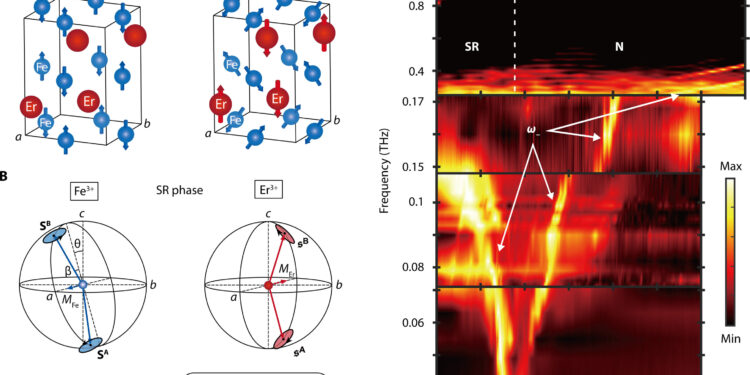Spectroscopic proof of the Magronique Srpt in Erfeo3. Credit: Scientific advances (2025). DOI: 10.1126 / SCIADV.ADT1691
A team of researchers from the University of Rice reported the first direct observation of a surprising quantum phenomenon predicted more than half a century ago, opening ways for revolutionary applications in quantum, communication and detection.
Known as superradiant phase transition (SRPT), the phenomenon occurs when two groups of quantum particles begin to fluctuate in a collectively coordinated manner without an external trigger, forming a new state of matter.
The discovery was made in a crystal composed of erbium, iron and oxygen which was cooled at less than 457 fahrenheit and exposed to a powerful magnetic field of up to 7 Tesla (more than 100,000 times stronger than the magnetic field of the earth), according to a study published in Scientific advances.
“Originally, the SRPT was proposed as resulting from interactions between quantum vacuum fluctuations – the light fields on the on the on the quantity, even in completely empty space – and fluctuations in matter,” said Dasom Kim, a doctoral student of rice in the program of applied physics diplomas which is a main author of the study.
“However, in our work, we have carried out this transition by coupling two distinct magnetic subsystems – spin fluctuations in iron ions and Erbium ions in the crystal.”
Spin describes the magnetic poles of electrons or other particles and can be considered as a tiny arrow attached to each particle, turning constantly and pointing in a given direction. When the towers line up, they create magnetic patterns through a material. When the motive of turns undulates through the material as a wave, the resulting collective excitation is known as Magnon.
Until now, the fact that an SRPT can really take place or not was subject to a debate when it takes place against a limitation – called “non -go theorem” in theoretical physics – coming from light -based systems. By staging an SRPT in a magnetic crystal based on the interactions between two subsystems of Spin, the researchers were able to bypass this barrier, creating a magronic version of the phenomenon.
More specifically, the magnons of iron ions play the role traditionally attributed to vacuum fluctuations, and the spins of Erbium ions represent fluctuations in matter.
Using advanced spectroscopic techniques, the researchers observed undoubted signatures of an SRPT, with the energy signal of a disappearing spin mode and another showing a change or a light fold. These spectral fingerprints correspond exactly to what the theory predicts to enter the superradiant phase, giving the team great confidence that they had actually cajolized the state wanted for a long time.
Dasom Kim. Credit: Jorge Vidal / Rice University
“We have established an ultrastrong coupling between these two spin systems and successfully observed an SRPT, overcoming the previous experimental constraints,” said Kim.
Researchers are excited not only because a 50 -year -old physical prediction has been confirmed, but also because of what it could mean for quantum technology. Collective quantum states of the SRPT have unique properties that could be exploited for new generation quantum technologies.
“Near the quantum critical point of this transition, the system naturally stabilizes quantum states – where quantum noise is considerably reduced – considerably improving measuring precision,” said Kim. “Overall, this idea could revolutionize quantum sensors and computer technologies, considerably progressing their loyalty, their sensitivity and their performance.”
SOHAIL DASGUPTA, a student graduated from Rice working with Kaden Hazzard, an associate professor of physics and astronomy, theoretically modeled the SRPT, based on a model developed by their collaborator and co-author Motoaki Bamba, professor at Yokohama National University.
“Although the basic mathematical mathematical model has already been presented before by Motoaki, we had to take into account some of the specific magnetic properties of the material to obtain precise results. When your theory corresponds to the experimental data ⎯ which occurs rather rarely ⎯, it is the best feeling for a scientist,” said Dasguta.
Hazzard said that the realization shows that the concepts of quantum optics can be translated into solid materials.
“This opens up a new way of creating and controlling the phases of matter using ideas for quantum electrodynamics of the cavity,” said Hazzard.
In addition, the crystal used in this study is an example of a broader class of materials, which means that research opens the way to the exploration of quantum phenomena in other materials with magnetic components in similar interaction.
“The demonstration of a fully trained SRPT form by cutting two internal material fluctuations marks an important breakthrough in quantum physics, establishing a new framework to understand and exploit the intrinsic quantum interactions within materials,” said Junichiro Kono, Karl F. Hasselmann Professor of Engineering, professor of electrical studies and computer engineering and materials of materials and materials of materials and materials of materials and Nanoengineering and study.
More information:
Dasom Kim et al, observation of the superradiant phase transition from the Magronique Dicke, Scientific advances (2025). DOI: 10.1126 / SCIADV.ADT1691
Supplied by Rice University
Quote: Scientists observe an exotic quantum phase formerly impossible (2025, April 14) recovered on April 15, 2025 from
This document is subject to copyright. In addition to any fair program for private or research purposes, no part can be reproduced without written authorization. The content is provided only for information purposes.



